Contactless payments: put the phone to the turnstile - and you're on the subway!
A telephone is not only a means of communication, but also a personal identifier and an account that are always with you. It is logical that with the help of a mobile phone it is possible and necessary to make payments - but until this year the technology was related rather to science fiction and a brighter future than to real use.
Nevertheless, the future is already here: Beeline has everything ready and tested to organize the service for paying for travel and other mass NFC applications.
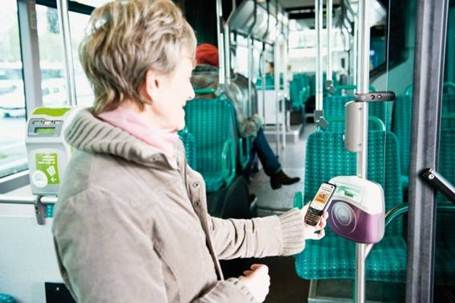
')
NFC (Near Field Communication) is a technology that transmits information at distances of up to 4 cm at a frequency of 13.56 MHz and a maximum speed of 424kbps. A key element of the ecosystem are contactless cards that provide data storage and exchange. We also need readers (turnstiles, “validators”) that authorize contactless cards. The technology is used for payments in automated accounting systems and access control. For example, it is security at facilities (enterprises, institutions, sports facilities, etc.) and public transport.
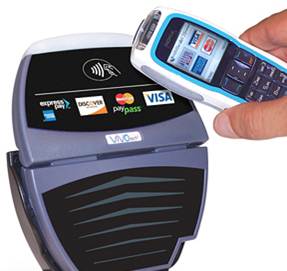
Payment by NFC-phone through a bank terminal
For driving on transport cards in the metro, urban ground transportation (now used in Moscow, St. Petersburg, Yekaterinburg and others), to pay for goods and services using contactless bank cards of Visa and MasterCard payment systems.
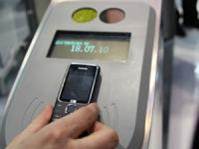
Payment by NFC-phone
Mobile phone allows you to combine services based on NFC and the possibility of interactive interaction in one device. Here and the transfer of information between mobile phones, and loyalty cards, and information and advertising services based on reading information from radio frequency tags (RFID). Thus, a mobile phone becomes not only a traditional means of communication, but also a universal payment instrument with additional services.
You can use a phone where the NFC module is built in at the factory, and you can use additional devices, such as NFC stickers and modules. Stickers can be attached to the body of the phone. Stickers are passive and active. Passive ones cannot exchange data with a mobile phone and, therefore, do not allow recording information to an NFC device via the mobile operator’s communication channels (via SMS or via the mobile Internet). Active users use a Wi-Fi or Bluetooth communication channel to communicate with the phone: this is either increased power consumption or the need to recharge the module separately. A common drawback of external modules is generally the presence of a mount.
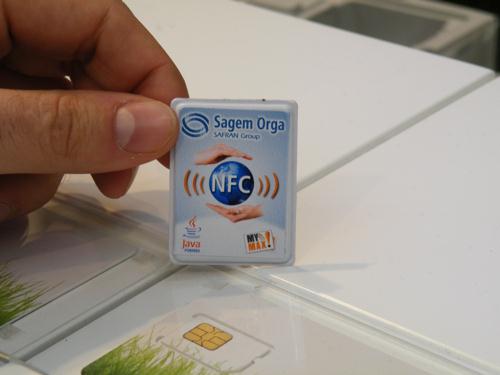
Sticker times
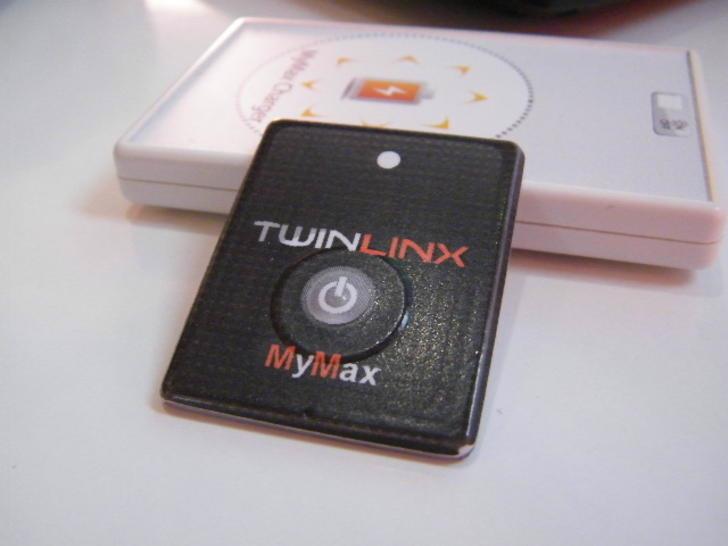
Sticker two
NFC-modules are installed inside the mobile phone and make it look like they could be assembled “at the factory”.
Yes, a large number of pilots with payment and transport services were initiated in the world. In the Russian Federation, one of such initiatives was made by Beeline, having implemented in June-July of this year a successful NFC project on travel in the St. Petersburg metro. Beeline subscribers were offered a mobile phone with a special application, equipped with an NFC-module.
A person with such a device can buy any transport ticket from the application. Payment for travel tickets is done directly from the subscriber’s mobile account. To use the ticket, it is enough to attach the mobile phone to the turnstile in the subway as a regular card.
NFC-module is embedded in the phone. It does not require replacement of the SIM card. You can install almost all modern phone models and a number of models of the past 5 years of release. This solution will be used until the long-awaited phones with NFC-modules built-in at the factory appear on the market.

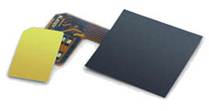
NFC module
Structurally, the module is made in an elastic case with a thickness of several millimeters and a size of 2 to 3 centimeters. An antenna is located on the perimeter of the module. From the case there is a flexible cable with a contact pad in the form of a SIM card. The thickness of the case and contact elements make it easy to place the module inside the phone directly under the case cover. The SIM card is combined with the module's contact pad, which has a reusable adhesive base, and is placed on the SIM contact pads in the phone. Simply put, the module is placed on the battery, and its contact pad is inserted into the holder along with the SIM card. All this is covered with a phone cover. At present, 4 types of modules have been developed, and so far the main obstacle for installation is not the “iron” of the phone, but rather the lack of a plastic cover.
The module has a microprocessor that provides reliable storage of service applications, cryptographic protection and supports three main communication channels.
1) NFC for contactless transactions
2) Information flow with TSM (Trusted Service Manager) via the mobile operator’s network
3) Data exchange with the user through the user interface - a mobile phone application.
Service applications - software modules (payment, transportation, loyalty cards, etc.) are stored in a security element protected by keys from unauthorized access.
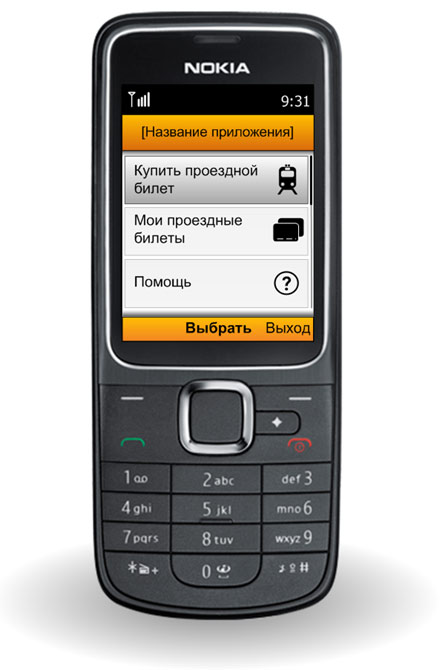
The user selects from the menu of the mobile phone which application to use, paying for this and that or another service. For example, in order to travel by metro, we select the number of trips we need through the menu and click "pay." Immediately after this, the mobile phone, or rather, the module sends a request to TSM for a purchase, forms a ticket, writes off funds and sends an electronic ticket back to the module to update the information in the transport application.
The transport application emulates Mifare, the standard used in contactless transport tickets. The turnstile "sees" the usual metro map similar to that bought at the ticket office, that is, it absolutely does not need to be redone.
TSM is a hardware and software complex that implements management functions for service applications, service users, software management for the module (and security element), encryption keys, etc. Data exchange between the module and TSM is realized through a mobile phone and traditional communication channels SMS or IP. From the point of view of the phone, the work of the module is the service activity of the SIM card.
After the tests, it became clear that the technology is just great. It is clear that we will most likely start with the passage, but I can already see how I can enter fast food, choose food right on the phone, attach it to the terminal and receive my tray, how people can use the phone instead of keys and even the wallet .
UPD . The question about security has been repeated several times. Information about the issued ticket is stored in the metro system and is associated with a unique module number (similar to SIM).
UPD 2 . Once again about the work of the module on the fingers: first you just have a phone. Then you upgrade it using a module that is inserted under the case and connects to the SIM card. Then buy, for example, 20 trips using the application. A ticket is generated for you in the metro system and is tied to the identifier of your module, the parameters of this ticket are transferred to the application and are written to the module. The part of the module that emulates the subway map now acts as this card inserted under the case. If the phone sits down, it will continue to work. If the module is removed from the phone, you can simply go through it (but you can’t buy a new ticket). The beauty of the method is precisely in the possibility of “flashing” the module with new cards, buying them through the application and writing off funds for such purchases from a mobile account. In principle, such a module can be not only a “subway map under the case”, but also a “chip” credit card with all the features and the same high protection.
Nevertheless, the future is already here: Beeline has everything ready and tested to organize the service for paying for travel and other mass NFC applications.

')
What is this technology?
NFC (Near Field Communication) is a technology that transmits information at distances of up to 4 cm at a frequency of 13.56 MHz and a maximum speed of 424kbps. A key element of the ecosystem are contactless cards that provide data storage and exchange. We also need readers (turnstiles, “validators”) that authorize contactless cards. The technology is used for payments in automated accounting systems and access control. For example, it is security at facilities (enterprises, institutions, sports facilities, etc.) and public transport.

Payment by NFC-phone through a bank terminal
Where is NFC used?
For driving on transport cards in the metro, urban ground transportation (now used in Moscow, St. Petersburg, Yekaterinburg and others), to pay for goods and services using contactless bank cards of Visa and MasterCard payment systems.

Payment by NFC-phone
How to tie NFC to the phone?
Mobile phone allows you to combine services based on NFC and the possibility of interactive interaction in one device. Here and the transfer of information between mobile phones, and loyalty cards, and information and advertising services based on reading information from radio frequency tags (RFID). Thus, a mobile phone becomes not only a traditional means of communication, but also a universal payment instrument with additional services.
You can use a phone where the NFC module is built in at the factory, and you can use additional devices, such as NFC stickers and modules. Stickers can be attached to the body of the phone. Stickers are passive and active. Passive ones cannot exchange data with a mobile phone and, therefore, do not allow recording information to an NFC device via the mobile operator’s communication channels (via SMS or via the mobile Internet). Active users use a Wi-Fi or Bluetooth communication channel to communicate with the phone: this is either increased power consumption or the need to recharge the module separately. A common drawback of external modules is generally the presence of a mount.

Sticker times

Sticker two
NFC-modules are installed inside the mobile phone and make it look like they could be assembled “at the factory”.
Were there pilot projects?
Yes, a large number of pilots with payment and transport services were initiated in the world. In the Russian Federation, one of such initiatives was made by Beeline, having implemented in June-July of this year a successful NFC project on travel in the St. Petersburg metro. Beeline subscribers were offered a mobile phone with a special application, equipped with an NFC-module.
A person with such a device can buy any transport ticket from the application. Payment for travel tickets is done directly from the subscriber’s mobile account. To use the ticket, it is enough to attach the mobile phone to the turnstile in the subway as a regular card.
And where is the module itself?
NFC-module is embedded in the phone. It does not require replacement of the SIM card. You can install almost all modern phone models and a number of models of the past 5 years of release. This solution will be used until the long-awaited phones with NFC-modules built-in at the factory appear on the market.


NFC module
Structurally, the module is made in an elastic case with a thickness of several millimeters and a size of 2 to 3 centimeters. An antenna is located on the perimeter of the module. From the case there is a flexible cable with a contact pad in the form of a SIM card. The thickness of the case and contact elements make it easy to place the module inside the phone directly under the case cover. The SIM card is combined with the module's contact pad, which has a reusable adhesive base, and is placed on the SIM contact pads in the phone. Simply put, the module is placed on the battery, and its contact pad is inserted into the holder along with the SIM card. All this is covered with a phone cover. At present, 4 types of modules have been developed, and so far the main obstacle for installation is not the “iron” of the phone, but rather the lack of a plastic cover.
The module has a microprocessor that provides reliable storage of service applications, cryptographic protection and supports three main communication channels.
1) NFC for contactless transactions
2) Information flow with TSM (Trusted Service Manager) via the mobile operator’s network
3) Data exchange with the user through the user interface - a mobile phone application.
Service applications - software modules (payment, transportation, loyalty cards, etc.) are stored in a security element protected by keys from unauthorized access.
How it works?

The user selects from the menu of the mobile phone which application to use, paying for this and that or another service. For example, in order to travel by metro, we select the number of trips we need through the menu and click "pay." Immediately after this, the mobile phone, or rather, the module sends a request to TSM for a purchase, forms a ticket, writes off funds and sends an electronic ticket back to the module to update the information in the transport application.
The transport application emulates Mifare, the standard used in contactless transport tickets. The turnstile "sees" the usual metro map similar to that bought at the ticket office, that is, it absolutely does not need to be redone.
TSM is a hardware and software complex that implements management functions for service applications, service users, software management for the module (and security element), encryption keys, etc. Data exchange between the module and TSM is realized through a mobile phone and traditional communication channels SMS or IP. From the point of view of the phone, the work of the module is the service activity of the SIM card.
How to buy a pie in 2020?
After the tests, it became clear that the technology is just great. It is clear that we will most likely start with the passage, but I can already see how I can enter fast food, choose food right on the phone, attach it to the terminal and receive my tray, how people can use the phone instead of keys and even the wallet .
UPD . The question about security has been repeated several times. Information about the issued ticket is stored in the metro system and is associated with a unique module number (similar to SIM).
UPD 2 . Once again about the work of the module on the fingers: first you just have a phone. Then you upgrade it using a module that is inserted under the case and connects to the SIM card. Then buy, for example, 20 trips using the application. A ticket is generated for you in the metro system and is tied to the identifier of your module, the parameters of this ticket are transferred to the application and are written to the module. The part of the module that emulates the subway map now acts as this card inserted under the case. If the phone sits down, it will continue to work. If the module is removed from the phone, you can simply go through it (but you can’t buy a new ticket). The beauty of the method is precisely in the possibility of “flashing” the module with new cards, buying them through the application and writing off funds for such purchases from a mobile account. In principle, such a module can be not only a “subway map under the case”, but also a “chip” credit card with all the features and the same high protection.
Source: https://habr.com/ru/post/128564/
All Articles